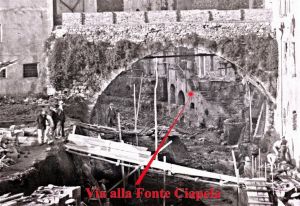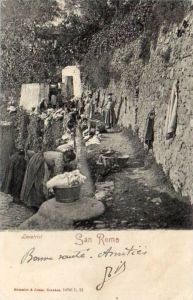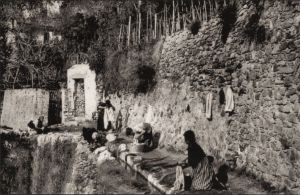The history of water in San Remo
(edited by Roberto Monfroni)
The history of the aqueducts
The scarcity of water in Western Liguria and in particular in Sanremo has always been a big problem in the past centuries and therefore we cannot avoid talking about the arrival of water in Sanremo.
The water supply of Sanremo has always been a problem and until 1828 the water arrived by occasional ways.
In the upper part of the city (la Pigna) the water, coming from underground aquifers or meteoric (rain, etc.) was stored in tanks scattered here and there, from which the various place names derive such as Via Cisterna, vicolo Cisternin or "funtanassa" to which a collection tank was annexed.
 In the flat part of the town, the system of wells (which fetched water from the few aquifers in the subsoil or from meteoric sources) and cisterns, in which water supplies were kept for periods of drought, was the only one in existence, and therefore the only one that allowed for water supply.
In the flat part of the town, the system of wells (which fetched water from the few aquifers in the subsoil or from meteoric sources) and cisterns, in which water supplies were kept for periods of drought, was the only one in existence, and therefore the only one that allowed for water supply.
The water extracted from the subsoil, however, as a doctor and hygienist of the time wrote, was « impure and slimy water, the source of gastroenteropathies, tapeworms, typhoid fevers, aso. ».
At the time, the water was supplied by a spring in the San Romolo stream, known as the Ciapéla spring, named after the homonymous bastion erected at the time as part of a defensive system against the Saracen invasions.
Located very low down, it was accessed by two flights of stairs.
For the vegetable gardens, irrigation was by deriving water from the streams or, where possible, from underground by digging wells. The water from the streams was collected by means of dams or sluices (ciüüse) across the watercourses and channelled along the banks of the valley into special earthen or masonry gutters (bii) and brought, by natural fall, to irrigate the land below in the respective valley.  Since the waters of the torrents, which were certainly not abundant, were state-owned, the institution of "devéu", or prohibition of drawing water by individuals to the detriment of others, had the force of law.
Since the waters of the torrents, which were certainly not abundant, were state-owned, the institution of "devéu", or prohibition of drawing water by individuals to the detriment of others, had the force of law.  During the hot season and on certain days of the week, municipal employees swore an oath to assign each user his share of the water, set in hours and minutes, opening and closing special openings (turseùi) in correspondence with the garden to be irrigated, allowing the passage of the precious but scarce element. The ringing of a bell marked the beginning and end of the allocation.
During the hot season and on certain days of the week, municipal employees swore an oath to assign each user his share of the water, set in hours and minutes, opening and closing special openings (turseùi) in correspondence with the garden to be irrigated, allowing the passage of the precious but scarce element. The ringing of a bell marked the beginning and end of the allocation.
With this system, the lands were considered sut'àiga (under the water), i.e. downstream of a water course and therefore of greater value than those located upstream, unable to enjoy such benefits. Of course, the system was not without its faults, and sometimes violent disputes broke out due to the failure to respect the time limits and the farmers' respective rights.
In some cases, the water along the path in the biu was also used as motive power for the numerous olive presses or mills and in the sections of biu made of masonry, the women spent hours and hours washing their clothes in running water.
Nowadays, there are only a few lost remnants of these biu here and there, bearing witness to a past of sacrifice and hard work. (from the Magazine "A Gardiöra no. 2 of 1985").




